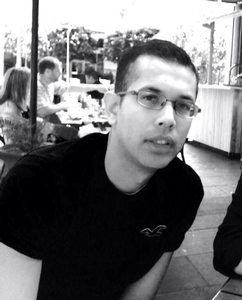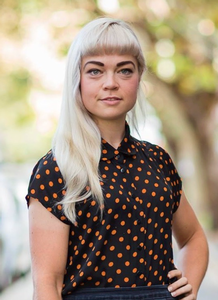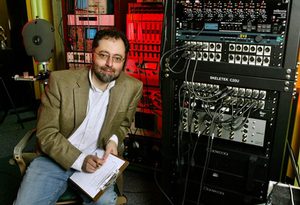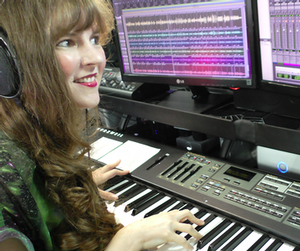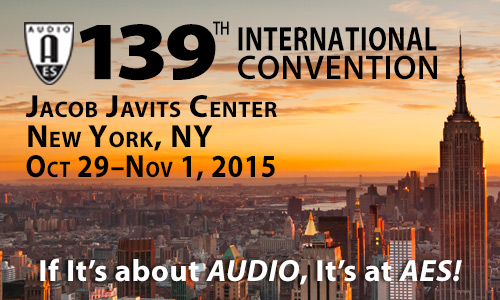
AES New York 2015
Game Audio Track Event Details
Thursday, October 29, 9:30 am — 10:30 am (Room 1A21)
Game Audio: G1 - Reinventing the Sound for Call of Duty: Advanced Warfare
Presenter:David Swenson, Sledgehammer Games - Activision
Abstract:
How do you go about reinventing the audio experience for a well-established game like Call of Duty? How do you make the audio sound fresh, next-gen and “Advanced” in the 11th installment of a franchise? The answers to these questions may surprise you. Learn how Sledgehammer Games employed some unorthodox methods to create an all new sound for Call of Duty.
Thursday, October 29, 1:00 pm — 2:00 pm (Room 1A23/24)
Special Event: Opening Ceremonies / Awards / Keynote Speech
Keynote Speaker:Michael Abrash, Oculus VR - USA
Presenters:
Jim Anderson, New York University - New York, NY, USA
Paul Gallo, Sports Video Group - New York, NY, USA; Director, DTV Audio Group
Andres A. Mayo, Andres Mayo Mastering & Audio Post - Buenos Aires, Argentina
Bob Moses, AES - Vashon Island, WA, USA
Frank Wells, AES/Blank Canvas Publishing/Clyne Media - Murfreesboro, TN, USA
Abstract:
The Keynote speaker for the 139th Convention is Michael Abrash.
Michael Abrash is Chief Scientist of Oculus VR. He was the GDI development lead for the first two versions of Windows NT, joined John Carmack to write Quake at Id Software, worked on the first two versions of Xbox, co-authored the Pixomatic software renderer at Rad Game Tools, worked on Intel’s Larrabee project, worked on both augmented and virtual reality at Valve, and currently leads the Oculus Research team. He is also the author of several books, including Michael Abrash’s Graphics Programming Black Book, and has written and spoken frequently about graphics, performance programming, and virtual reality. The title of his talk is "Virtual Reality, Audio, and the Future." Michael Abrash will talk about why virtual reality is unique and potentially world-changing, and about how and why audio research and development will play a key part in the future of VR.
Thursday, October 29, 2:15 pm — 3:15 pm (Room 1A21)
Game Audio: G2 - VR Game Audio: The Importance of Sound Propagation
Presenter:Ravish Mehra, Oculus Research - Redmond, WA, USA
Abstract:
Realistic sound propagation is extremely important for VR game audio for improving the sense of presence and immersion of the player in the virtual environment. Sound propagation cues can provide additional information about the game environment (small vs large, inside vs outside) and about events happening outside the field-of-view (such as enemy sneaking from behind). Most current games use simple techniques, such as pre-baked reverb filters, to generate the game sound. These techniques do not respond to the dynamic aspects of the game (e.g., moving sources, listeners, objects) and also do not model the various acoustic effects produced by propagation of sound (e.g., echoes, low-passing, scattering, focusing). In many cases, the sound engine is not given access to the underlying scene geometry to compute these propagation effects. In this presentation, I talk about the importance of accurate sound propagation for VR applications and how it can improve the overall experience of the player in VR games.
Thursday, October 29, 3:30 pm — 5:00 pm (Room 1A12)
Game Audio: G3 - Audio Shorts: Indie Edition
Presenters:Alexis Brandow, Creative Director and Owner of Amorse Inc. - Los Angeles, CA, USA
Damien DiFede, Gameplay Programmer, Kokoromi
Garrett Nantz, Luxurious Animals - New York, NY, USA
Matt Piersall, New School Beast Handler, Gl33k - Austin, TX, USA
Abstract:
Big games from little studios. Three presenters get only 30 minutes each to serve up an in-depth look at topics in game audio tech that matter most to them. Q&A to follow.
Shorty #1: The All Music Game: Inside the Tech and Design of Cosmic DJ This talk delves in to the tech and design challenges of developing a music creation game. It's a peek behind the curtain of the custom code and tools written that allowed players the ability to create their own music within our rule-set. The talk delves into the audio side of creating the content as well as the "jam-responses" and metronome system used to drive the entire game experience from the players musical input. In addition the talk will take a look inside the generative final music creator that allowed players to export their songs and share them. Matt Piersall, Dmien Di Fede
Shorty #2: Adventures with Midi in Audio Game Development
When making audio games the big challenge is crunching down large audio sizes to keep file sizes manageable. The Notespace team used midi solutions on various games within our musical activity book, Notespace Beat, to address this problem. In this conversation we would like to share with you the challenges and advantages we found in implementing Midi technology. We also would like to address briefly some recommendations based on our experience for recording and sharing audio across PC and iOS mobile platforms. Alexis Brandow
Shorty #3: Breaking the 3D Sound Barrier
Until recently, recreating three dimensional audio on the web has been a difficult and limiting task. With modern browsers finally supporting more robust audio systems, web audio can finally rival sound experiences traditionally found only on desktop and mobile apps. Using the award-winning Lux Ahoy www.luxahoy.com and Feisty Galaxies www.feistygalaxies.com games, we will take a behind the scenes look at the process for creating audio for browser-based games using the Dolby Digital Plus E-AC-3 codec and the Web Audio API. Topics covered will include how to create and encode surround sound and video for the web, methods for your audience to hear 3D sound, stereo audio fallback support, tricks and techniques, creating memorable sound effects, audio loop creation, and music sourcing.
Thursday, October 29, 5:15 pm — 6:15 pm (S-Foyer 1)
Game Audio: G4 - Audio Shorts/Posters
Presenters:Alexis Brandow, Creative Director and Owner of Amorse Inc. - Los Angeles, CA, USA
Damien DiFede, Gameplay Programmer, Kokoromi
Garrett Nantz, Luxurious Animals - New York, NY, USA
Matt Piersall, New School Beast Handler, Gl33k - Austin, TX, USA
Abstract:
Immediately following Audio Shorts: Indie Edition, walk over to the Posters area to see short demonstrations from each of the presenters. As in the Shorts format, each presenter only get 20 minutes. Think of this as a lab class where can get a hands on demo of what you just saw in class.
Shorty #1: Audio Driven Design: The Cosmic DJ Workflow: Typically audio is the last thing in the pipeline for most games. Cosmic DJ took the opposite approach. During the development of Cosmic DJ the team relied on audio to be created first to drive design. That workflow lead the team to create toolsets that were completely based on music sequencing, giving the entire experience a natural musical feel.
Shorty #2: Notespace Beat Audio Games Demo: A Notespace team member will be demoing midi games from Notespace Beat. The Orbitron game will show how we mixed a midi track with a background soundtrack. The Synthball game will show how we determined a correct key stroke and the way we ultimately decided to time it with the background music. The Do tempo game, will further illustrate the timing solutions we used with midi.
Shorty #3: Web Sound Insights: The Audio Shorts session for Breaking the Gaming 3D Sound Barrier will give individuals an opportunity to experience the Lux Ahoy and Feisty Galaxies web games first hand while getting a chance to ask Garrett Nantz specific questions about how the 3D and Dolby audio segments were created.
Friday, October 30, 10:00 am — 10:45 am (Room 1A18)
Game Audio: Repeat of G1: Reinventing the Sound for Call of Duty: Advanced Warfare
Abstract:
Because Session G1 was so popular we've arranged to repeat it in the PMC room at 10am on Friday. This session will be limited to 60 people.
How do you go about reinventing the audio experience for a well-established game like Call of Duty? How do you make the audio sound fresh, next-gen and “Advanced” in the 11th installment of a franchise? The answers to these questions may surprise you. Learn how Sledgehammer Games employed some unorthodox methods to create an all new sound for Call of Duty.
Friday, October 30, 1:45 pm — 2:45 pm (Room 1A21)
Game Audio: G5 - Just Cause 3: Postmortem on the Game Audio of a Massive Open World Game
Presenters:Jason Kanter, Audio Lead, Avalanche Studios - New York, NY, USA
Dominic Vega, Sound Designer, Avalanche Studios - New York City, NY USA
Abstract:
Open world sandbox games (OWS) are arguably the most challenging to provide sound for. Two members from Avalanche Studios’ audio department present what it was like providing game audio for one of the largest OWS’s in the genre. Spanning 3½ years in development across two continents with a content creation team fluctuating in size from 1–4½ people, the audio department on JC3 had their fair share of obstacles. Jason and Dom will discuss what it was like to create the soundtrack for a world filled with fast cars, big guns and even bigger explosions in a Southern European Mediterranean island setting, all while attempting to keep the game as “Made in NY” as possible.
Friday, October 30, 4:30 pm — 5:30 pm (Room 1A07)
Paper Session: P12 - Game Audio
Chair:
Michael Kelly, DTS, Inc. - London, UK
P12-1 Real-Time Morphing of Impact Sounds—Sadjad Siddiq, Square Enix Co., Ltd. - Tokyo, Japan
This paper introduces an algorithm to morph between two or more sounds, which can be used to synthesize new sounds in real-time whose features lie between the tone color, amplitude envelope, pitch, and length of the source sounds. It is used to increase variation of commonly used impact sounds in video games, but the algorithm can also be applied to other sound types like instrument sounds. Morphing of the tone color is achieved by shifting formants in the frequency spectrum of one sound toward the frequencies of the corresponding formants in the other sounds. Corresponding formants are found automatically by pairing frequency regions of equal normalized cumulative energy. Morphing of the temporal structure is achieved by aligning those frames of all sounds that have equal normalized cumulative amplitude. A link to samples is provided.
Convention Paper 9407 (Purchase now)
P12-2 Using Pure Data as a Game Audio Engine—Leonard J. Paul, School of Video Game Audio - Vancouver, Canada
Recent improvements in the Pure Data (Pd) library library code (libpd) and significant run-time improvements using the Heavy compiler have made Pd more viable as a free audio engine for use in video games. Open source projects are now available to help speed the process of integrating Pd into the popular Unity game and create new possibilities for the use of Pd by game studios with limited budgets and for educational purposes as well. Details on best practices on the use of Pd for audio in video games are outlined in this paper.
Convention Paper 9408 (Purchase now)
Saturday, October 31, 9:00 am — 9:45 am (Room 1A14)
Game Audio: G6 - 3D Audio for Virtual Reality
Presenter:Frederick Umminger, Sony Computer Entertainment America
Abstract:
Overview of some of the engineering problems and challenges in developing a 3D audio solution suitable for widespread use in virtual reality and ordinary gaming, and some of the impacts on mixing workflows.
Saturday, October 31, 11:45 am — 12:45 pm (Room 1A14)
Game Audio: G7 - The Audio Implementation Arms Race: Implementation as a Weapon
Presenter:Sally-anne Kellaway, Firelight Technologies - Melbourne, VIC, Australia
Abstract:
Overview of some of the engineering problems and challenges in developing a 3D audio solution suitable for widespread use in virtual reality and ordinary gaming and some of the impacts on mixing workflows.
In the realm of game audio, the race to make interactive and adaptive audio implementation accessible to the entire game
development team is on. Developers of game engines and audio middleware solutions are making their products more accessible to wider markets by including more tools and UI improvements for absolute beginners and audio professionals alike. Sally Kellaway will discuss the current challenges this movement poses to game audio professionals, and, using FMOD Studio as a lens, illustrate the value in extending a sound design skill base to take command of this element of the audio pipeline. Sound implementation will be explored for the potential it holds, focussing on the value of new tools and workflows that are on offer to sound designers and project teams. This discussion will enable sound designers to argue the value of upgrading and taking ownership of the audio pipeline to include advanced implementation tools.
Saturday, October 31, 2:00 pm — 3:30 pm (Room 1A22)
Game Audio: G8 - Game Audio Careers - Blazing a Path to Your Future
Chair:Stephen Harwood, Jr., Education Working Group Chair; IASIG - New York, NY, USA
Panelists:
Bonnie Bogovich, Schell Games - Pittsburgh, PA, USA
Jacques Deveau, Audiokinetic - Montreal, QC, Canada
Jason Kanter, Audio Lead, Avalanche Studios - New York, NY, USA
Tom Salta, Persist Music - Norwalk, CT, USA
Brian Walker, Audio Director, Leap Frog - San Francisco, CA; Manhattan Producers Alliance
Abstract:
Games are big business. From social and mobile games to consoles the field is diverse and growing. So what is the best way to get that first gig in audio for games? How can I transfer my existing skills to interactive media? We will take a panel of today’s top creative professionals from large game studios to Indie producers and ask them what they think you need to know when looking for work in the game industry. So, whether you are already working in the game industry or just thinking of the best way to transfer your skills from film, TV or general music production to interactive media or a complete newbie to the industry, this panel is a must!
Saturday, October 31, 3:30 pm — 5:00 pm (Room 1A22)
Game Audio: G9 - Game Audio Education—New Opportunities for Students
Chair:Steve Horowitz, Game Audio Institute - San Francisco, CA, USA; Nick Digital
Panelists:
Scott Looney, Academy of Art University - San Francisco, CA, USA
Leonard J. Paul, School of Video Game Audio - Vancouver, Canada
Winifred Phillips, Generations Productions LLC - New York City Metropolitan Area
Michael Sweet, Berklee College of Music - Boston, MA, USA
Abstract:
Game Audio education programs are starting to take root and sprout up all over the world. Game audio education is becoming a hot topic. What are some of the latest training programs out here? What are the pros and cons of a degree program versus just getting out there on my own? I am already a teacher, how can I start a game audio program at my current school? Good questions! This panel brings together entrepreneurs from some of the top private instructional institutions and teachers from some growing programs to discuss the latest and greatest educational models in audio for interactive media. Attendees will get a fantastic overview of what is being offered inside and outside of the traditional education system. This is a must for students and teachers alike, who are trying to navigate the waters and steer a path toward programs that are right for them in the shifting tides of audio for games and interactive media.
Sunday, November 1, 9:00 am — 10:00 am (Room 1A22)
Game Audio: G10 - Virtual Reality 3D Audio - State of the Art & Vision of the Near Future
Presenter:Edgar Choueiri, Princeton University - Princeton, NJ, USA
Abstract:
Starting with a brief review of the three main methods for 3-D sound reproduction over loudspeakers: (1) Wave Field Synthesis, (2) Ambisonics, and (3) Binaural audio through two loudspeakers (BAL), we focus on recent advances with the third method. I will show that crosstalk cancellation (XTC) allows BAL to deliver to the listener the necessary cues for real 3-D audio but that it inherently imposes an intolerably high spectral coloration on the audio. I will describe recent breakthroughs, which allow producing optimized XTC filters that impose no spectral coloration. I will then discuss the two other problems that have retarded the commercialization of XTC: the fixed and single sweet spot problems. I will show how the first problem is solved through advanced head tracking; and the second problem is solved using head tracking and phased array speakers, allowing the delivery of high-spatial-fidelity 3D audio to multiple moving listeners in real listening rooms. Following the talk, there will be a demo with playback of recorded music and natural sounds.
Sunday, November 1, 11:30 am — 12:30 pm (Room 1A22)
Game Audio: G11 - Interactive Music of the LittleBigPlanet Franchise: Dissecting A Complex, Multi-Component System
Presenter:Winifred Phillips, Generations Productions LLC - New York City Metropolitan Area
Abstract:
This talk will explore the structure and deployment strategies for multiple music tracks composed in a system of dynamic layers for six LittleBigPlanet games. Composer Winifred Phillips has over 11 years of game industry experience, including six games in the famous LittleBigPlanet franchise: LittleBigPlanet 2, LittleBigPlanet Toy Story, LittleBigPlanet Cross Controller, LittleBigPlanet PS Vita, LittleBigPlanet Karting, and LittleBigPlanet 3. This talk will cover issues of importance to composers, audio engineers and sound designers when working with a highly layered music system. Attendees will be alerted to common problems associated with a layered system, and Phillips will reveal useful tips that she learned along the way, and common sense strategies that can be employed for any layered music system, whether it’s designed to be modest or large-scale.

